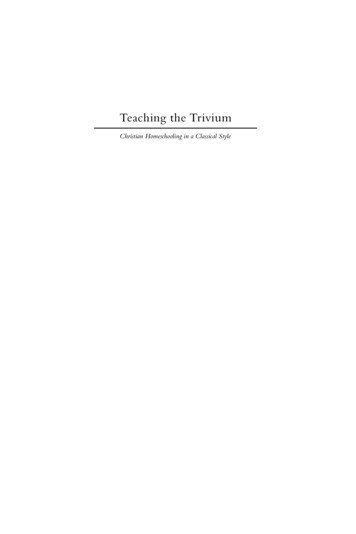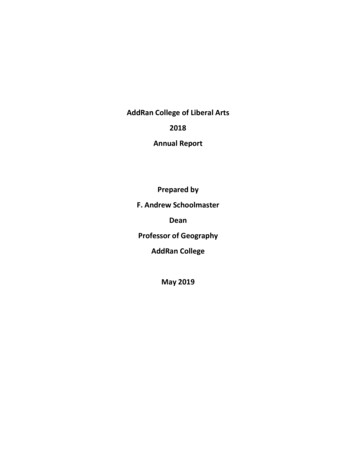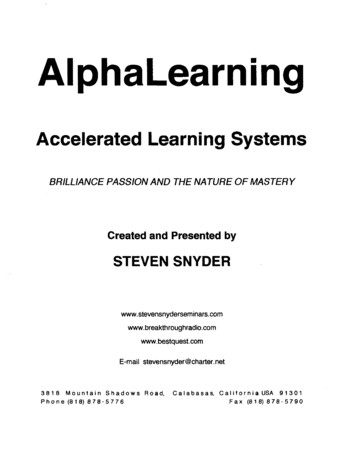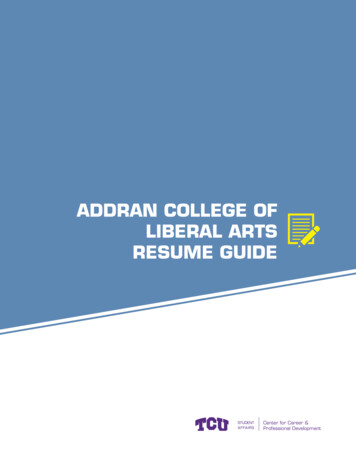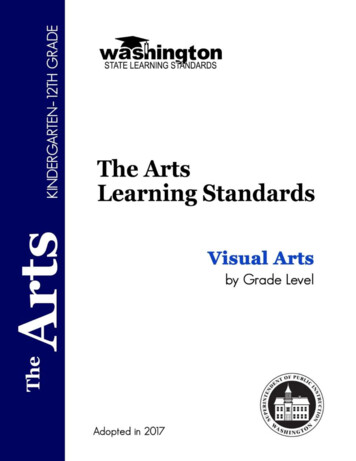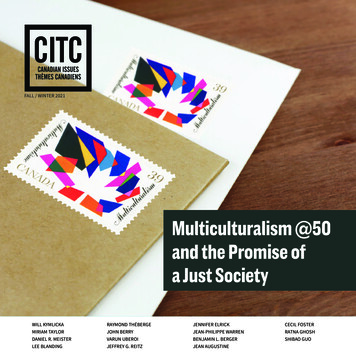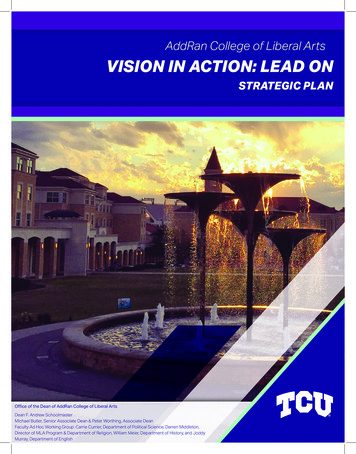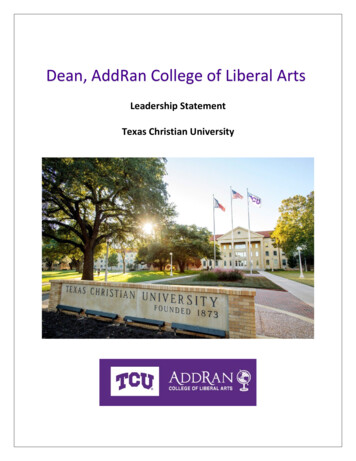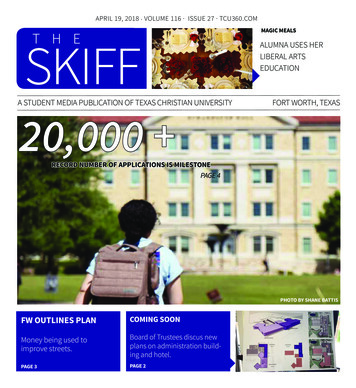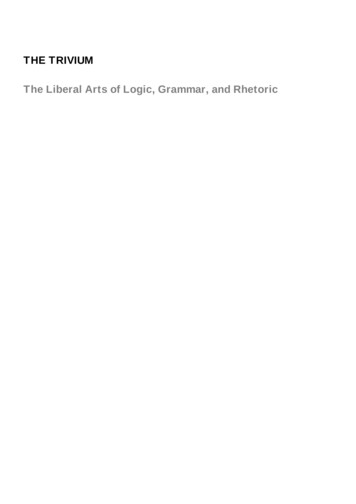
Transcription
THE TRIVIUMThe Liberal Arts of Logic, Grammar, and Rhetoric
THE TRIVIUM
THE LIBERAL ARTS OF LOGIC, GRAMMAR,AND RHETORIC
UNDERSTANDINGTHEFUNCTION OF LANGUAGENATURE AND
BY SISTER MIRIAM JOSEPH, C.S.C., Ph.D.EDIT ED BY MARGUERIT E McGLINNPAUL DRY BOOKSPhiladelphia 2002
Firt Paul Dry Books Edition, 2002Paul Dry Books, Inc.Philadelphia, Pennslvaniawww.pauldrybooks.comCopyright 2002 Paul Dry Books, Inc.Copyright 1937, 1940, 1948 Sister Miriam Joseph, C.S.C.All rights reservedText type: ElectraDisplay type: Fenice and Anitique OliveComposed by Northeastem Graphic Services, Inc.Disigned by Adrianne Onderdonk DuddenPhotograph of Sister Mirian Joseph courtesy of the Saint Mary’s College Archives15 16 17 18 19Printed in the United States of AmericaLibrary of Congress Cataloging-in-Publication DataMiriam Joseph, Sister, 1898–The trivium : the liberal arts of logic, grammmar, and rhetoric: understanding the natureand function of language / by Sister Miriam Joseph ; edited by Marguerite McGlinn.p.cm.ISBN 0-9679675-0-3 (pbk : alk. paper)ISBN 1-58988-013-7 (cloth : alk. paper)I. English language—Rhetoric. 2. English language—Grammar. 3. Readingcomprehension. 4. Language and logic. 5. Critical thinking. I. McGlinn, Marguerite. II. Title.PE1408 .M568 2002808′.042—dc21
2001058498
ContentsEditor’s Introduction1 THE LIBERAL ARTS2 THE NATURE AND FUNCTION OF LANGUAGE3 GENERAL GRAMMAR4 TERMS AND THEIR GRAMMATICAL EQUIVALENTS:DEFINITION AND DIVISION5 PROPOSITIONS AND THEIR GRAMMATICALEXPRESSION6 RELATIONS OF SIMPLE PROPOSITIONS7 THE SIMPLE SYLLOGISM8 RELATIONS OF HYPOTHETICAL ANDDISJUNCTIVE PROPOSITIONS9 FALLACIES10 A BRIEF SUMMARY OF INDUCTION11 COMPOSITION AND READINGNotesSister Miriam Joseph (1899–1982)Index
Editor’s Introduction“In true liberal education the essential activity of the student is to relate the factslearned into a unified, organic whole, to assimilate them as the rose assimilates foodfrom the soil and increases in size, vitality, and beauty.”The Trivium: The Liberal Arts of Logic, Grammar, and RhetoricWhat is language? How does it work? What makes good language? Coleridge definedprose as “words in their best order” and poetry as “the best words in the best order.” Plainbut apt, his definitions provide a standard, but where can a reader and a writer find thetools to achieve this standard? My search drew me to Sister Miriam Joseph’s book, TheTrivium. I knew that the skills I had learned as a liberal arts student, taught as a highschool English teacher, and use as a writer and editor derived from the medieval andRenaissance approach to grammar, logic, and rhetoric, the three “language arts” of theliberal arts known as the trivium. However, a study of the original trivium showed me thatthe hodgepodge of grammar rules, literary terms, and syllogistic formulas offered as“language arts” differs from the original conception of the trivium that offered tools toperfect the mind.Sister Miriam Joseph rescued that integrated approach to unlocking the power of themind and presented it for many years to her students at Saint Mary’s College in SouthBend, Indiana. She learned about the trivium from Mortimer J. Adler, who inspired her andother professors at Saint Mary’s to study the trivium themselves and then to teach it totheir students. In Sister Miriam Joseph’s preface to the 1947 edition of The Trivium, shewrote, “This work owes its inception to Professor Mortimer J. Adler of the University ofChicago, whose inspiration and instruction gave it initial impulse.” She went on toacknowledge her debt to Aristotle, John Milton, and Jacques Maritain. WilliamShakespeare, Thomas Aquinas, and Thomas More also make frequent appearances inThe Trivium. This is good company indeed.The Trivium teaches us that language evolves from the very nature of being human.Because we are rational, we think; because we are social, we interact with other people;because we are corporeal, we use a physical medium. We invent symbols to express therange of practical, theoretical, and poetical experiences that make up our existence.Words allow us to leave a legacy of our experience to delight and to educate those whofollow us. Because we use language, we engage in a dialogue with the past and thefuture.How does The Trivium help us use language to engage in such a dialogue with the pastand the future and to negotiate our own lives? Aristotle’s theories of language andliterature underlie this work. His ten categories of being provide a central focus. Words arecategorized by their relationship to being and to each other. When a speaker or writeruses a word, thus assigning it a particular meaning, it becomes a term and enters therealm of logic. Aristotle’s categories enable us to translate the linguistic symbol into alogical entity ready to take its place in a proposition. From propositions, the reader movesto syllogisms, enthymemes, sorites, formal fallacies, and material fallacies.The Trivium explains that logic is the art of deduction. As thinking beings, we knowsomething and from that knowledge can deduce new knowledge. Where does the initialknowledge come from? The section on induction answers that question as it explores theprocess by which we derive general principles from individual instances.Examples from the literary canon and Shakespeare, in particular, illuminate theexplanations of grammar and logic. Sister Miriam Joseph, who was also a Shakespeareanscholar, actually wrote about Shakespeare as a master of the trivium. For example, heoften used litotes, the figure of speech based on the obversion of a proposition. TheTempest shows one instance of this. Sebastian, expressing his concern over the fate ofFerdinand, the king’s son, says, “I have no hope that he’s undrowned.” Shakespearemakes the rhetorical decision to use obversion to dramatize that Sebastian faces a reality
he cannot describe in direct speech.Rhetoric concerns the choices a speaker or writer makes from the options grammar andlogic offer. Sister Miriam Joseph reviews the history of rhetoric and presents Aristotle’sperspective on the means of persuasion. She includes poetics—communication throughthe narrative created by the author—in addition to rhetoric or direct communication. Here,the reader will find Aristotle’s six elements of poetics. The section on plot is extensive andincludes a detailed analysis of structure in Guy de Maupassant’s “The Piece of String.” Inthe service of rhetoric and poetics, Sister Miriam Joseph explains figurative languageaccording to the classical topics of invention from which they are derived, poetry andversification, and the essay. The chapter ends with a brief guide to composition.As this summary indicates, The Trivium provides a comprehensive view of grammar,logic, and rhetoric as well as of induction, poetics, figurative language, and poetry. Thereader could, however, use parts of the book separately. Chapters One to Three: “TheLiberal Arts,” “The Nature and Function of Language,” and “General Grammar” offer aguide to an integrated view of language. The logic section comprises Chapters Four toNine. Chapter Ten, “A Brief Summary of Induction,” presents the types of induction andscientific method. Chapter Eleven, “Reading and Composition,” explains concepts ofrhetoric and other literature. The few references to logic in Chapters Ten and Eleven areexplained in the notes.The notes are a new feature in this edition of The Trivium. Todd Moody, Professor ofPhilosophy at Saint Joseph’s University in Philadelphia, provided commentary andamplification on the logic chapters. His notes are designated TM. My notes giveetymologies, the source for quotations, and clarifications. Some notes repeat informationfrom earlier chapters that I thought would be helpful to the reader.The original publication had sketchy documentation of quotations. I researched all thequotations, and I used contemporary standard editions for frequently cited sources, suchas Shakespeare’s plays or the Bible. In a few cases, I could find the work cited but not theactual quotation. Saint Thomas More’s Confutation Concerning Tyndale’ s Answers, forexample, is a three-volume work in Renaissance prose. In one case, however, I wasdelighted not only to find the actual book, an out-of-print and now little-known book onlogic, but to find the actual quotation.The issue of gender and language occasioned several discussions among the editorialstaff. In The Trivium Sister Miriam Joseph uses he and man to refer to all human beings;that was the accepted procedure in the 1930s and the 1940s, and it suited a book thatused classical, medieval, and Renaissance sources. I left the text unchanged except foroccasional substitutions of plural words or expressions like human being for man.In her edition of The Trivium, Sister Miriam Joseph used an outline form. This editionadapts that outline by using equivalent headings and by providing transitions. I also madedistinctions between information and examples; in the original text, examples, illustrations,analogies, and notes were incorporated into the outline. In my own study of this trivium, Ifound that certain sections were key to understanding the work as a whole or werevaluable additions to my understanding of language. I have presented these sections asdisplays in this edition, and they should serve the reader both in a first reading of TheTrivium and also in a review of the text.The author chose wonderful, literary examples for every chapter of the book. Thisedition keeps those selections. Occasionally, poems were mentioned but not included; thisedition includes the poems. In some cases, Sister Miriam Joseph used quotations from, orreferences to, contemporary periodicals. Because they have lost their relevance, Isubstituted literary references.I would like to thank the many people who helped bring this new edition of The Triviumto publication. John Kovach, librarian at Saint Mary’s College, found the original Triviumand sent it to Paul Dry Books. Professor John Pauley of Saint Mary’s College wrote SisterMiriam Joseph’s biography for this edition. Todd Moody provided an invaluable service inreading and commenting on the logic chapters. He helped me clarify the text, and heanswered all my questions affably and quickly. Darryl Dobbs, Professor of Political Scienceat Marquette University, read drafts at various stages and provided helpful commentary.
Martha Robinson, a member of the Christian Trivium Board, reviewed a draft, and heradvice helped me sharpen the focus. I would also like to thank Thomas McGlinn, myhusband, who patiently sat through evening meals peppered with conundrums aboutgrammar and logic as I worked my way through this project.In editing The Trivium, I tried to do no harm to the original text and to be true to thevision and learning of the author and of her teachers. In the “Prologue” to The CanterburyTales, Chaucer asks the audience to forgive him if he offends anyone or makes a mistake.He concludes by explaining, “My wit is short, ye may wel understonde.” I invoke the samedefense.Ultimately, Sister Miriam Joseph speaks the most eloquently about the value of thisbook. She explains that studying the liberal arts is an intransitive activity; the effect ofstudying these arts stays within the individual and perfects the faculties of the mind andspirit. She compares the studying of the liberal arts with the blooming of the rose; it bringsto fruition the possibilities of human nature. She writes, “The utilitarian or servile artsenable one to be a servant—of another person, of the state, of a corporation, or of abusiness—and to earn a living. The liberal arts, in contrast, teach one how to live; theytrain the faculties and bring them to perfection; they enable a person to rise above hismaterial environment to live an intellectual, a rational, and therefore a free life in gainingtruth.”Marguerite McGlinnPhiladelphia, 2002
THE TRIVIUMThe Liberal Arts of Logic, Grammar, and Rhetoric
1 THE LIBERAL ARTST HE LIBERAL ART SThe liberal arts denote the seven branches of knowledge that initiate the young into a lifeof learning. The concept is classical, but the term liberal arts and the division of the artsinto the trivium and the quadrivium date from the Middle Ages.T he T rivium and the QuadriviumThe trivium1 includes those aspects of the liberal arts that pertain to mind, and thequadrivium, those aspects of the liberal arts that pertain to matter. Logic, grammar, andrhetoric constitute the trivium; and arithmetic, music, geometry, and astronomy constitutethe quadrivium. Logic is the art of thinking; grammar, the art of inventing symbols andcombining them to express thought; and rhetoric, the art of communicating thought fromone mind to another, the adaptation of language to circumstance. Arithmetic, the theoryof number, and music, an application of the theory of number (the measurement ofdiscrete quantities in motion), are the arts of discrete quantity or number. Geometry, thetheory of space, and astronomy, an application of the theory of space, are the arts ofcontinuous quantity or extension.The Trivium: The t hree art s of language pert aining t o t he mindLo g i ca rt o f t h i n ki n gGra m m a ra rt o f i n ven t i n g a n d c o m b i n i n g sym b o l sR h eto ri ca rt o f c o m m u n i c a t i o nThe Quadrivium: The four art s of quant it y pert aining t o mat t erDiscrete quantity or numberAri th m eti ct h eo ry o f n u m b erM us i ca p p l i c a t i o n o f t h e t h eo ry o f n u m b erContinuous quantity
Geo m etryt h eo ry o f sp a c eAs tro n o m ya p p l i c a t i o n o f t h e t h eo ry o f sp a c e1-1 The Seven Liberal ArtsThese arts of reading, writing, and reckoning have formed the traditional basis of liberaleducation, each constituting both a field of knowledge and the technique to acquire thatknowledge. The degree bachelor of arts is awarded to those who demonstrate therequisite proficiency in these arts, and the degree master of arts, to those who havedemonstrated a greater proficiency.Today, as in centuries past, a mastery of the liberal arts is widely recognized as the bestpreparation for work in professional schools, such as those of medicine, law, engineering,or theology. Those who first perfect their own faculties through liberal education arethereby better prepared to serve others in a professional or other capacity.The seven liberal arts differ essentially from the many utilitarian arts (such as carpentry,masonry, plumbing, salesmanship, printing, editing, banking, law, medicine, or the care ofsouls) and from the seven fine arts (architecture, instrumental music, sculpture, painting,literature, the drama, and the dance), for both the utilitarian arts and the fine arts aretransitive activities, whereas the essential characteristic of the liberal arts is that they areimmanent or intransitive activities.The utilitarian artist produces utilities that serve the wants of humanity; the fine artist, ifhe is of the highest order, produces a work that is “a thing of beauty and a joy forever” 2and that has the power to elevate the human spirit. In the exercise of both the utilitarianand the fine arts, although the action begins in the agent, it goes out from the agent andends in the object produced and usually has a commercial value; and therefore the artist ispaid for the work. In the exercise of the liberal arts, however, the action begins in the agentand ends in the agent, who is perfected by the action; consequently, the liberal artist, farfrom being paid for his hard work, of which he receives the sole and full benefit, usuallypays a teacher to give needed instruction and guidance in the practice of the liberal arts.The intransitive character of the liberal arts may be better understood from thefollowing analogy.ANALOGY: The int ransit ive charact er of t he liberal art sThe carpenter planes the wood.The rose blooms.The action of a transitive verb (like planes) begins in the agent but “goes across” and ends inthe object (the wood). The action of an intransitive verb (like blooms) begins in the agent andends in the agent (the rose, which is perfected by blooming).Classes of GoodsThe three classes of goods—valuable, useful, and pleasurable—illustrate the same typeof distinction that exists among the arts.Valuable goods are those which are not only desired for their own sake but which
increase the intrinsic worth of their possessor. For instance, knowledge, virtue, and healthare valuable goods.Useful goods are those which are desired because they enable one to acquire valuablegoods. For instance, food, medicine, money, tools, and books are useful goods.Pleasurable goods are those which are desired for their own sake because of thesatisfaction they give their possessor. For instance, happiness, an honorable reputation,social prestige, flowers, and savory food are pleasurable goods. They do not add to theintrinsic worth of their possessor, nor are they desired as means, yet they may beassociated with valuable goods or useful goods. For instance, knowledge, which increasesworth, may at the same time be pleasurable; ice cream, which is nourishing food, promoteshealth, and is, at the same time, enjoyable.The utilitarian or servile arts enable one to be a servant—of another person, of thestate, of a corporation, or of a business—and to earn a living. The liberal arts, in contrast,teach one how to live; they train the faculties and bring them to perfection; they enable aperson to rise above his material environment to live an intellectual, a rational, andtherefore a free life in gaining truth. Jesus Christ said, “You shall know the truth, and thetruth shall make you free” (John 8:32).3The new motto of Saint John’s College, Annapolis, Maryland, expresses the purpose ofa liberal arts college with an interesting play on the etymology of liberal: “Facio liberos exliberis libris libraque.” “I make free men of children by means of books and a balance[laboratory experiments].” 4Science and ArtEach of the liberal arts is both a science and an art in the sense that in the province ofeach there is something to know (science) and something to do (art). An art may be usedsuccessfully before one has a formal knowledge of its precepts. For example, a child ofthree may use correct grammar even though the child knows nothing of formal grammar.Similarly, logic and rhetoric may be effectively used by those who do not know theprecepts of these arts. It is, however, desirable and satisfying to acquire a clear knowledgeof the precepts and to know why certain forms of expression or thought are right andwrong.The trivium is the organon, or instrument, of all education at all levels because the artsof logic, grammar, and rhetoric are the arts of communication itself in that they govern themeans of communication—namely, reading, writing, speaking, and listening. Thinking isinherent in these four activities. Reading and listening, for example, although relativelypassive, involve active thinking, for we agree or disagree with what we read or hear.The trivium is used vitally when it is exercised in reading and composition. It wassystematically and intensively exercised in the reading of the Latin classics and in thecomposition of Latin prose and verse by boys in the grammar schools of England and thecontinent during the sixteenth century. This was the training that formed the intellectualhabits of Shakespeare and other Renaissance writers. The result of it appears in theirwork. (See T.W. Baldwin, William Shakespeare’s Small Latine and Lesse Greeke. Urbana:The University of Illinois Press, 1944.5) The trivium was basic also in the curriculum ofclassical times, the Middle Ages, and the post-Renaissance.In the Greek grammar of Dionysius Thrax (ca.166 B.C .), the oldest extant book ongrammar6 and the basis for grammatical texts for at least thirteen centuries, grammar isdefined in so comprehensive a manner that it includes versification, rhetoric, and literarycriticism.Grammar is an experimental knowledge of the usages of languages as generallycurrent among poets and prose writers. It is divided into six parts: (1) trainedreading with due regard to prosody [versification]; (2) exposition, according topoetic figures [rhetoric]; (3) ready statement of dialectical peculiarities and
allusion; (4) discovery of etymologies; (5) the accurate account of analogies; (6)criticism of poetical productions which is the noblest part of grammatical art.Because communication involves the simultaneous exercise of logic, grammar, andrhetoric, these three arts are the fundamental arts of education, of teaching, and of beingtaught. Accordingly, they must be practiced simultaneously by both teacher and pupil. Thepupil must cooperate with the teacher; he must be active, not passive. The teacher maybe present either directly or indirectly. When one studies a book, the author is a teacherindirectly present through the book. Communication, as the etymology of the wordsignifies, results in something possessed in common; it is a oneness shared.Communication takes place only when two minds really meet. If the reader or listenerreceives the same ideas and emotions that the writer or speaker wished to convey, heunderstands (although he may disagree); if he receives no ideas, he does not understand;if different ideas, he misunderstands. The same principles of logic, grammar, and rhetoricguide writer, reader, speaker, and listener.Liberal Arts EducationEducation is the highest of arts in the sense that it imposes forms (ideas and ideals) noton matter, as do other arts (for instance carpentry or sculpture) but on mind. These formsare received by the student not passively but through active cooperation. In true liberaleducation, as Newman7 explained, the essential activity of the student is to relate thefacts learned into a unified, organic whole, to assimilate them as the body assimilates foodor as the rose assimilates food from the soil and increases in size, vitality, and beauty. Alearner must use mental hooks and eyes to join the facts together to form a significantwhole. This makes learning easier, more interesting, and much more valuable. Theaccumulation of facts is mere information and is not worthy to be called education since itburdens the mind and stultifies it instead of developing, enlightening, and perfecting it.Even if one forgets many of the facts once learned and related, the mind retains the vigorand perfection gained by its exercise upon them. It can do this, however, only by grapplingwith facts and ideas. Moreover, it is much easier to remember related ideas than unrelatedideas.Each of the liberal arts has come to be understood not in the narrow sense of a singlesubject but rather in the sense of a group of related subjects. The trivium, in itself a tool ora skill, has become associated with its most appropriate subject matter—the languages,oratory, literature, history, philosophy. The quadrivium comprises not only mathematics butmany branches of science. The theory of number includes not merely arithmetic but alsoalgebra, calculus, the theory of equations, and other branches of higher mathematics. Theapplications of the theory of number include not only music (here understood as musicalprinciples, like those of harmony, which constitute the liberal art of music and must bedistinguished from applied instrumental music, which is a fine art) but also physics, much ofchemistry, and other forms of scientific measurement of discrete quantities. The theory ofspace includes analytic geometry and trigonometry. Applications of the theory of spaceinclude principles of architecture, geography, surveying, and engineering.The three R’s—reading, writing, and reckoning—constitute the core not only ofelementary education but also of higher education. Competence in the use of languageand competence in handling abstractions, particularly mathematical quantities, areregarded as the most reliable indexes to a student’s intellectual caliber. Accordingly, testshave been devised to measure these skills, and guidance programs in colleges and in thearmed forces have been based on the results of such tests.The three arts of language provide discipline of mind inasmuch as mind finds expressionin language. The four arts of quantity provide means for the study of matter inasmuch asquantity—more precisely, extension—is the outstanding characteristic of matter.(Extension is a characteristic of matter only, whereas number is a characteristic of both
matter and spirit.) The function of the trivium is the training of the mind for the study ofmatter and spirit, which together constitute the sum of reality. The fruit of education isculture, which Matthew Arnold 8 defined as “the knowledge of ourselves [mind] and theworld [matter].” In the “sweetness and light” of Christian culture, which adds to theknowledge of the world and ourselves the knowledge of God and of other spirits, we areenabled truly to “see life steadily and see it whole.” 9T HE LANGUAGE ART ST he Language Arts and RealityThe three language arts can be defined as they relate to reality and to each other.Metaphysics or ontology,10 the science of being, is concerned with reality, with the thingas-it-exists. Logic, grammar, and rhetoric have the following relation to reality.Logic is concerned with the thing-as-it-is-known.Grammar is concerned with the thing-as-it-is-symbolized.Rhet oric is concerned with the thing-as-it-is-communicated.1-2 Language and RealityILLUSTRATION: Relat ionship bet ween met aphysics and language art sThe discovery of the planet Pluto in 1930 illustrates the relationship between metaphysics andthe language arts. The planet Pluto had been a real entity, traveling in its orbit about our sun,for centuries; its discovery in 1930 did not create it. By being discovered, however, it became in1930 for the first time a logical entity. When it was named Pluto, it became a grammaticalentity. When by its name knowledge of it was communicated to others through the spokenword and also through the written word, the planet Pluto became a rhetorical entity.11Rhetoric is the master art of the trivium,12 for it presupposes and makes use of grammarand logic; it is the art of communicating through symbols ideas about reality.Comparison of Materials, Functions, and Norms of the Language ArtsThe language arts guide the speaker, writer, listener, and reader in the correct andeffective use of language. Phonetics and spelling, which are allied to the art of grammar,are included here to show their relationship to the other language arts in materials,functions, and norms.Phonet ics prescribes how to combine sounds so as to form spoken words correctly.
Spelling prescribes how to combine letters so as to form written words correctly.Grammar prescribes how to combine words so as to form sentences correctly.Rhet oric prescribes how to combine sentences into paragraphs and paragraphs into a wholecomposition having unity, coherence, and the desired emphasis, as well as clarity, force, andbeauty.Logic prescribes how to combine concepts into judgments and judgments into syllogisms andchains of reasoning so as to achieve truth.1-3 Language Arts: Their Materials and FunctionsBecause rhetoric aims for effectiveness rather than correctness, it deals not only withthe paragraph and the whole composition but also with the word and the sentence, for itprescribes that diction be clear and appropriate and that sentences be varied in structureand rhythm. It recognizes various levels of discourse, such as the literary (maiden ordamsel, steed), the common (girl, horse), the illiterate (gal, hoss), the slang (skirt, plug), thetechnical (homo sapiens, equus caballus), each with its appropriate use. The adaptationof language to circumstance, which is a function of rhetoric, requires the choice of acertain style and diction in speaking to adults, of a different style in presenting scientificideas to the general public, and of another in presenting them to a group of scientists.Since rhetoric is the master art of the trivium, it may even enjoin the use of bad grammaror bad logic, as in the portrayal of an illiterate or stupid character in a story.Just as rhetoric is the master art of the trivium, so logic is the art of arts because itdirects the very act of reason, which directs all other human acts to their proper endthrough the means it determines.In the preface to his Art of Logic, the poet Milton remarks:The general matter of the general arts is either reason or speech. They areemployed either in perfecting reason for the sake of proper thinking, as in logic, orin perfecting speech, and that either for the sake of the correct use of words, asin grammar, or the effective use of words, as in rhetoric. Of all the arts the firstand most general is logic, then grammar, and last of all rhetoric, since there canbe much use of reason without speech, but no use of speech without reason. Wegave the second place to grammar because correct speech can be unadorned;but it can hardly be adorned before it is correct.13Because the arts of language are normative, they are practical studies as contrastedwith speculative. A speculative study is one that merely seeks to know—for example,astronomy. We can merely know about the heavenly bodies. We cannot influence theirmovements.A practical, normative study is one that seeks to regulate, to bring into conformity with anorm or standard—for example, ethics. The norm of ethics is the good, and its purpose isto bring human conduct into conformity with goodness.Correct ness is the norm of phonetics, spelling, and grammar.
Effect iveness is the norm of rhetoric.Trut h is the norm of logic. Correctness in thinking is the normal means to reach truth, which isthe conformity of thought with things as they are—with reality.1-4 Language Arts: Their NormsThe intellect itself is perfected in its operatio
As this summary indicates, The Trivium provides a comprehensive view of grammar, logic, and rhetoric as well as of induction, poetics, figurative language, and poetry. The reader could, however, use parts of the book separately. Chapters One to Three: "The Liberal Arts," "The Nature and Function of Language," and "General Grammar .
